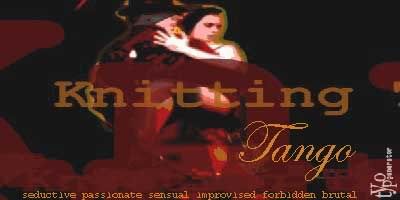What the Heck Has Knitting to Do With the Tango, Anyway?
Well, so much, really. In the way that everything is really closely related to everything else. Sort of a "six degrees of separation" thing.
Tango is a dance of improvisation. A dance that has humble beginnings among the poor, downtrodden and marginalized. It borrows from many cultures - South American Indian, Western European, Caribbean. The music likewise is an amalgam of instruments and cultural influences. However, even in the midst of so much improvisation, spontaneity and vibrancy, there are specific rules. The direction of movement about the floor, the types of pacing crucial to a tango being not merely a tango, but ...A TANGO. Tango was a dance for the men, primarily. And it is said to have been danced primarily in the brothels of Argentina, perhaps as a cover for the real business there, perhaps as a diversion whilst one awaited his turn...
At any rate, the Tango has a long and varied history, and as a dance it has enjoyed several peaks - firstly, when it was legitimized by being danced by a crowd that included those with money and social status (as opposed to just prostitutes, gangsters and dock workers), again as it spread to Europe in the early part of the 20th century, again in the 50s, and most recently with the birth of several exhibition Tango musicals to tour the world.
Knitting has so many parallels: humble beginnings; an endeavor for men rather than women; multicultural influences in pattern, color, technique and structure, many of which were improvised rather than taught; and times in history when it enjoyed relatively increased popularity, acceptance, elevation from being a necessity to being a leisure pursuit.
Even the act of knitting runs parallel to dancing Tango, for me. A pair of (perhaps deadly) needles, the sensuous aspects of the fiber, the dance between the needles - the lead - and the fiber - the follow. Or perhaps the dance between the hands as the lead and the fiber or the needles as the follow. The need for both structure and spontaneity to create a beautiful fabric that makes the heart, the hand, and the eyes rejoice. The devastation that the knitter feels when fiber or tools betray. The pain sometimes inflicted on the knitter by the act of knitting. And, perhaps most importantly, the passion most knitters feel for their craft, which is also a love, and a luxurious, leisure-time pursuit that yet yields an object of useful value. Knitting seduces wholly.
Dancing a Tango can last a mere three minutes, or a lifetime. Knitting can possess the spirit of either commitment or dalliance, depending upon the scope of the project and the investment of money, time and soul the knitter chooses to make. In the best marriages, the spirit of both commitment and dalliance are present. Tango holds that possibility for us. As does knitting.
Dance on.
Tango is a dance of improvisation. A dance that has humble beginnings among the poor, downtrodden and marginalized. It borrows from many cultures - South American Indian, Western European, Caribbean. The music likewise is an amalgam of instruments and cultural influences. However, even in the midst of so much improvisation, spontaneity and vibrancy, there are specific rules. The direction of movement about the floor, the types of pacing crucial to a tango being not merely a tango, but ...A TANGO. Tango was a dance for the men, primarily. And it is said to have been danced primarily in the brothels of Argentina, perhaps as a cover for the real business there, perhaps as a diversion whilst one awaited his turn...
At any rate, the Tango has a long and varied history, and as a dance it has enjoyed several peaks - firstly, when it was legitimized by being danced by a crowd that included those with money and social status (as opposed to just prostitutes, gangsters and dock workers), again as it spread to Europe in the early part of the 20th century, again in the 50s, and most recently with the birth of several exhibition Tango musicals to tour the world.
Knitting has so many parallels: humble beginnings; an endeavor for men rather than women; multicultural influences in pattern, color, technique and structure, many of which were improvised rather than taught; and times in history when it enjoyed relatively increased popularity, acceptance, elevation from being a necessity to being a leisure pursuit.
Even the act of knitting runs parallel to dancing Tango, for me. A pair of (perhaps deadly) needles, the sensuous aspects of the fiber, the dance between the needles - the lead - and the fiber - the follow. Or perhaps the dance between the hands as the lead and the fiber or the needles as the follow. The need for both structure and spontaneity to create a beautiful fabric that makes the heart, the hand, and the eyes rejoice. The devastation that the knitter feels when fiber or tools betray. The pain sometimes inflicted on the knitter by the act of knitting. And, perhaps most importantly, the passion most knitters feel for their craft, which is also a love, and a luxurious, leisure-time pursuit that yet yields an object of useful value. Knitting seduces wholly.
Dancing a Tango can last a mere three minutes, or a lifetime. Knitting can possess the spirit of either commitment or dalliance, depending upon the scope of the project and the investment of money, time and soul the knitter chooses to make. In the best marriages, the spirit of both commitment and dalliance are present. Tango holds that possibility for us. As does knitting.
Dance on.




<< Home